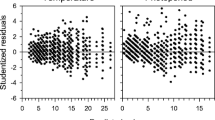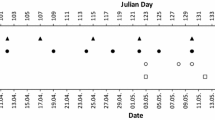Abstract
Flushing in spring marks an important adaptive process in a tree’s growth cycle. We studied bud burst in three provenances of a common small tree Frangula alnus Mill., originating from Italy, Belgium and Sweden. We observed timing of bud burst and leaf senescence in a common garden, and timing and duration of bud burst in greenhouse conditions (cuttings) with different temperature regimes, all located in Belgium. The early bud burst response of the southern European provenance together with the later leaf senescence compared to the local provenance indicated population differentiation that may, at least partly, be driven by local adaptation to a longer growing season. The duration of the process was longer in the cold greenhouse compared to the local provenance, whereas it responded similar as the local provenance in the warm greenhouse, suggesting adaptation to warmer conditions. Unexpectedly, the northern European provenance expressed a plastic reaction to warmer temperatures in the field trial and in the greenhouse conditions flushing in both cases earlier than the local provenance. The duration of the process in the warm greenhouse compared to the local provenance was shorter, whereas in the cold greenhouse it was similar. This result again suggested that not only the onset, but also the duration of the bud burst process was a plastic reaction to the warmer conditions compared to its site of origin. Together, our results suggest two mechanisms driving bud burst in F. alnus provenances, a co-gradient and a counter-gradient variation depending on the latitude of origin.



Similar content being viewed by others

References
Alberto F, Aitken S, Alía R, González-Martínez S, Hänninen H, Kremer A, Lefèvre F, Lenormand T, Yeaman S, Whetten R, Savolainen O (2013) Potential for evolutionary responses to climate change—evidence from tree populations. Glob Change Biol 19:1645–1661
Alberto F, Bouffier L, Louvet JM, Lamy JB, Delzon S, Kremer A (2011) Adaptive responses for seed and leaf phenology in natural populations of sessile oak along an altitudinal gradient. J Evol Biol 24:1442–1454
Basler D, Körner C (2014) Photoperiod and temperature responses of bud swelling and bud burst in four temperate forest tree species. Tree Physiol. doi:10.1093/treephys/tpu021
Bennie J, Kubin E, Wiltshire A, Huntley B, Baxter R (2010) Predicting spatial and temporal patterns of bud-burst and spring frost risk in north-west Europe: the implications of local adaptation to climate. Glob Change Biol 16:1503–1514. doi:10.1111/j.1365-2486.2009.02095
Bertin RI (2008) Plant phenology and distribution in relation to recent climate change. J Torrey Bot Soc 135:126–146
Caffarra A, Donnelly A (2011) The ecological significance of phenology in four different tree species: effects of light and temperature on bud burst. Int J Biometeorol 55:711–721. doi:10.1007/s00484-010-0386-1
Ceulemans R, Scarascia-Mugnozza GE, Wiard JH, Braatne BM, Hinckley TM, Stettler RF, Isebrands JG, Heilman PE (1992) Production physiology and morphology of Populus species and their hybrids grown under short rotation. I. Clonal comparisons of 4-year growth and phenology. Canad J Forest Res 22:1937–1948
Christensen RHB (2013) Ordinal: regression models for ordinal data. R package version 2013.10-31. Available at: http://www.cran.r-project.org/package=ordinal/. Accessed 1 Nov 2014
DeBell DS, Harrington CA, Clendenen GW, Zasada JS (1997) Tree growth and stand development of four Populus clones in large monoclonal plots. New Forest 14:1–18
Ducousso A, Guyon JP, Kremer A (1996) Latitudinal and altitudinal variation of bud burst in western populations of sessile oak (Quercus petraea (Matt.) Liebl.). Ann Sci Forest 53:775–782
Hannerz M (1999) Evaluation of temperature models for predicting bud burst in Norway spruce. Canad J Forest Res 29:9–19. doi:10.1139/Cjfr-29-1-9
Hannerz M, Ekberg I, Norell L (2003) Variation in chilling requirements for completing bud rest between provenances of Norway spruce. Silvae Genet 52:161–168
Hijmans RJ, Cameron SE, Parra JL, Jones PG, Jarvis A (2005) Very high resolution interpolated climate surfaces for global land areas. Int J Climatol 25:1965–1978
Hunter MD (1992) A variable insect–plant interaction: the relationship between tree bud burst phenology and population levels of insect herbivores among trees. Ecol Entomol 16:91–95
Kremer A, Ronce O, Robledo-Arnuncio JJ, Guillaume F, Bohrer G, Nathan R, Bridle JR, Gomulkiewicz R, Klein EK, Ritland K, Kuparinen A, Gerber S, Schueler S (2012) Long-distance gene flow and adaptation of forest trees to rapid climate change. Ecol Letters 15:378–392. doi:10.1111/j.1461-0248.2012.01746
Laikre L, Schwartz MK, Waples RS, Ryman N (2010) Compromising genetic diversity in the wild: unmonitored large-scale release of plants and animals. Trends Ecol Evol 25:520–529
Lindner M, Maroschek M, Netherer S, Kremer A, Barbati A, Garcia-Gonzalo J, Seidl R, Delzon S, Corona P, Kolstrom M, Lexer MJ, Marchetti M (2010) Climate change impacts, adaptive capacity, and vulnerability of European forest ecosystems. Forest Ecol Managem 259:698–709. doi:10.1016/j.foreco.2009.09.023
Matesanz S, Gianoli E, Valladares F (2010) Global change and the evolution of phenotypic plasticity in plants. Ann New York Acad Sci 1206:35–55
Matesanz S, Valladares F (2014) Ecological and evolutionary responses of Mediterranean plants to global change. Environm Exp Bot 103:53–67
Medan D (1994) Reproductive biology of Frangula alnus Miller in southern Spain. Pl Syst Evol 193:173–186
McKay JK, Christian CE, Harrison S, Rice KJ (2005) “How local is local?”—a review of practical and conceptual issues in the genetics of restoration. Restorat Ecol 13:432–440
McKown AD, Guy RD, Klapste J, Geraldes A, Friedmann M, Cronk QCB, El-Kassaby YA, Mansfield SD, Douglas CJ (2014) Geographical and environmental gradients shape phenotypic trait variation and genetic structure in Populus trichocarpa. New Phytol 201:1263–1276
Murray M, Cannell M, Smith R (1989) Date of budburst of fifteen tree species in Britain following climatic warming. J Appl Ecol 26:693–700
Myneni RB, Keeling CD, Tucker CJ, Asrar G, Nemani RR (1997) Increased plant growth in the northern high latitudes from 1981 to 1991. Nature 386:698–702
Neale DB, Kremer A (2011) Forest tree genomics: growing resources and applications. Nat Rev Genet 12:111–122
Oleksyn J, Modrzynski J, Tjoelker MG, Zytkowiak R, Reich PB, Karolewski P (1998) Growth and physiology of Picea abies populations from elevational transects: common garden evidence for altitudinal ecotypes and cold adaptation. Funct Ecol 12:573–590. doi:10.1046/j.1365-2435.1998.00236
Olson MS, Levsen N (2012) Classic clover cline clues. Molec Ecol 21:2315–2317. doi:10.1111/j.1365-294X.2012.05503
Olsson C, Bolmgren K, Lindstrom J, Jonsson AM (2013) Performance of tree phenology models along a bioclimatic gradient in Sweden. Ecol Modelling 266:103–117. doi:10.1016/j.ecolmodel.2013.06.026
R Core Team (2013) R: A language and environment for statistical computing. R Foundation for Statistical Computing. Vienna, Austria. Available at: http://www.r-project.org/. Accessed 1 Nov 2014
Robson TM, Alia R, Bozic G, Clark J, Forsteuter M, Gomory D, Liesebach M, Mertens P, Rasztovits E, Zitova M, vonWuhlisch G (2011) The timing of leaf flush in European beech (Fagus sylvatica L.) saplings. Genetic resources of European beech (Fagus sylvatica L.) for sustainable forestry, Proceedings of the COST E52 final meeting, Serie Forestal 22:61–80
Robson TM, Rasztovits E, Aphalo PJ, Alia R, Aranda I (2013) Flushing phenology and fitness of European beech (Fagus sylvatica L.) provenances from a trial in La Rioja, Spain, segregate according to their climate of origin. Agric Forest Meteorol 180:76–85. doi:10.1016/j.agrformet.2013.05.008
Rohde A, Bastien C, Boerjan W (2011) Temperature signals contribute to the timing of photoperiodic growth cessation and bud set in poplar. Tree Physiol 31:472–482. doi:10.1093/treephys/tpr038
Rousi M, Pusenius J (2005) Variations in phenology and growth of European white birch (Betula pendula) clones. Tree Physiol 25:201–210
Savolainen O, Pyhäjärvi T, Knürr T (2007) Gene flow and local adaptation in trees. Annu Rev Ecol Evol Syst 38:595–619. doi:10.1146/annurev.ecolsys.38.091206.095646
Seppälä R, Buck A, Katila P (2009) Adaptation of forests and people to climate change. A global assessment report, vol 22. IUFRO World Series, Helsinki
Soularue JP, Kremer A (2012) Assortative mating and gene flow generate clinal phenological variation in trees. BMC Evol Biol. doi:10.1186/1471-2148-12-79
Tanino KK, Kalcsits L, Silim S, Kendall E, Gray GR (2010) Temperature-driven plasticity in growth cessation and dormancy development in deciduous woody plants: a working hypothesis suggesting how molecular and cellular function is affected by temperature during dormancy induction. Pl Molec Biol 73:49–65. doi:10.1007/s11103-010-9610-y
Vander Mijnsbrugge K, Bischoff A, Smith B (2010) A question of origin: where and how to collect seed for ecological restoration. Basic Appl Ecol 11:300–311
Vander Mijnsbrugge K, Onkelinx T, De Cuyper B (2015) Variation in bud burst and flower opening responses of local versus non-local provenances of hawthorn (Crataegus monogyna Jacq.) in Belgium. Pl Syst Evol 301:1171–1179. doi:10.1007/s00606-014-1141-6
Vitasse Y, Bresson CC, Kremer A, Michalet R, Delzon S (2010) Quantifying phenological plasticity to temperature in two temperate tree species. Funct Ecol 24:1211–1218. doi:10.1111/j.1365-2435.2010.01748
Vitasse Y, Delzon S, Bresson CC, Michalet R, Kremer A (2009) Altitudinal differentiation in growth and phenology among populations of temperate-zone tree species growing in a common garden. Canad J Forest Res 39:1259–1269. doi:10.1139/X09-054
vonWuehlisch G, Krusche D, Muhs HJ (1995) Variation in temperature sum requirement for flushing of beech provenances. Silvae Genet 44:343–346
Williams M, Dumroese R (2014) Assisted migration: what it means to nursery managers and tree planters. Tree Planters’ Notes 57:21–26
Acknowledgments
We like to thank Hanne De Kort for sample collection. We also thank Stefaan Moreels for all the nursery work and André Meersman for field evaluations.
Author information
Authors and Affiliations
Corresponding author
Ethics declarations
Conflict of interest
The authors declare that they have no conflict of interest.
Additional information
Handling editor: Walter Durka.
Rights and permissions
About this article
Cite this article
Vander Mijnsbrugge, K., Turcsán, A. & Michiels, B. Population differentiation and phenotypic plasticity in temperature response of bud burst in Frangula alnus provenances of different latitude. Plant Syst Evol 302, 257–264 (2016). https://doi.org/10.1007/s00606-015-1258-2
Received:
Accepted:
Published:
Issue Date:
DOI: https://doi.org/10.1007/s00606-015-1258-2



